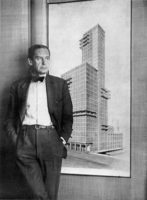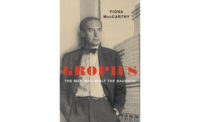From Architectural Record, March 1956
Architectural Record has asked me to state both what troubles me most and what pleases me most in the status of architecture in the United States.
In the May issue of 1937 shortly after I had entered this, my adopted country, for good, Architectural Record published a statement about my general intentions as newly-appointed Harvard Professor of Architecture. I emphasized that "it should be our highest aim to produce a type of architect who is able, to visualize an entity rather than let himself get absorbed into the narrow channels of specialization . . . to make way for the man of vision."
Have we made any progress towards this goal? Indeed we have. During the last twenty years, a young American generation of talented architects has come to the fore--among them, I am proud to say, many of my own former students whose achievements show definite signs of a growing coherence and kinship of the American architectural idiom.
Comparing publications on European architecture with those on American design, the latter stands out; in its generally more direct, fresh and flexible solutions, less inhibited, less tempered by prejudice. In a country that is blessed with abundance, an enviable array of technical means offers opportunities for daring experiments, and this challenge has been enthusiastically met.
What a contrast to the early days when we struggled with the first letters of the new architectural alphabet, hemmed in on all sides by colossal prejudices and barely able to surmount, the technical difficulties that beset, all attempts at creating new, unprecedented forms for living. We were lonely fighters with insufficient equipment, with uncertain allies, and practical demonstrations of our ideas were few and far between.
Now, when a new generation is able to use the architectural language of the twentieth century as a matter of course, when prejudice has died down and a building program is in progress that supersedes any expectation, we architects find ourselves still at a fair distance from our desired goal: the transformation of our chaotic, profusely growing surroundings into a pattern of organic entity and visual bliss.
For such a desire has hardly taken root yet within our American population as a whole; we are still without their response and encouragement. We are still in danger of losing control over the vehicle of progress which our time has created. The misuse of the machine tends to flatten the mind, leveling off individual diversity and independence of thought and action.
But diversity is, after all, the very source of true democracy! But factors of expediency, like high-pressure salesmanship and money-making as an end in itself, have impaired the individual's capacity to seek and understand the deeper potentialities of life from which the culture of a nation develops. Our sense of neighborly integration, our love of beauty as a basic life requirement, are underdeveloped.
We need, on the one hand, distinct diversity of minds resulting from intensive individual performance, and, on the other, a common idiom of regional expression springing from the cumulative experience of successive generations who gradually weed out the superfluous and the merely arbitrary from the essential and typical. Such a voluntary selective process, far from producing dull uniformity, should give many individuals a chance to contribute their own individual variation of a common theme and so help to evolve again the integrated pattern for living that we lost with the advent of the machine age.
The two opposites--individual variety, and a common denominator expressed by creating form symbols of human fellowship--need to be reconciled to each other. The degree of success in shaping and fusing these opposites indicates the depth of culture reached and is the very yardstick for judging the architectural achievements of a period.
Our scientific age of specialization, with its glorious achievements for our physical life, has simultaneously brought about confusion and a general dissolution of context; it has resulted in shrinking and fragmentizing life.
But there are indications that we are slowly moving away from overspecialization and its perilous atomizing effect on the social coherence of the community. Many ideas and discoveries of our present civilization are wholly concerned with finding again the relationship between the phenomena of the universe, which scientists had so far viewed only in isolation from neighboring fields.
The scientist has contributed new knowledge of the identity of matter and energy. The artist, the architect, has learned to express visibly with inert materials a new dimension--time and motion. Are we on the way to regaining a comprehensive vision of the oneness of the world which we had let disintegrate? In the gigantic task of its reunification, the architect and planner will have to play a big role.
He must be well trained not ever to lose a total vision in spite of the wealth of specialized knowledge which he has to absorb and integrate. He must comprehend land, nature, man and his art as one great entity. In our mechanized society, we should patiently emphasize that we are still a world of men, that man in his natural environment must be the focus of all planning and building.
If we, the architects and planners, envisage the strategic goal of our profession in its vast complexity, it indeed embraces the civilized life of man in all its major aspects: the destiny of the land, the forests, the water, the cities and the countryside; the knowledge of man through biology, sociology and psychology; law, government and economics, art, architecture and engineering.
As all are interdependent, we cannot consider them separately in compartments. Their connectedness, directed toward a cultural entity, is undoubtedly of greater importance for success in planning our environment than finding ever-so-perfect practical solutions for limited objectives. If we agree on this rank of order, then the emphasis must be on the "composite mind," as we may call it, developed through a process of continuous cross-checking and balancing, rather than on the specialized expert who shuns responsibility for the whole and divides his brain into tight compartments.
To rebalance our life and to humanize the impact of the machine, we must give the creative architect, the artist, his chance to reassert himself as the prototype of "whole man." As soon as the longing for "total architecture," as I like to call it, becomes more universal, there will grow a demand for "experiments in living," for courageous practical attempts to examine the living value of our building and planning habits by setting up organic model communities where our new living standards can be tested and demonstrated.
As soon as the average American, with his innate enthusiasm and readiness to act, will feel the need for a more beautiful and more organically coherent environment as an expression of his pride and participation in our democracy, then he may cause a chain reaction conducive to solving our great and complicated task, to have both, unity and diversity, the two indispensable components of a cultural order.












